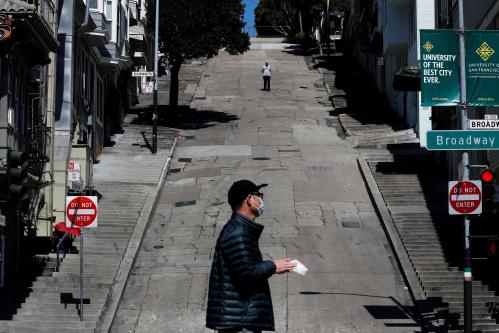The economic consequences of the COVID-19 crisis are unfolding at breakneck speed, affecting every sector of the U.S. economy from businesses large and small, education from Pre-K thru higher ed, and government institutions at all levels. Workers in these sectors are already on layoff, and scores more are forecasted to face layoffs in the coming weeks and months. This pandemic-led economic collapse is unprecedented in our lifetimes, and it requires an immediate and aggressive fiscal policy response to shorten the duration and intensity of the economic pain to American families and businesses.
We recommend a package of multiple direct stimulus payments of $1500 per adult and $500 per child, with a $4000 maximum per family. Median family income in 2018 was just over $78,000, and thus this transfer would cover about 60 percent of median monthly income. Importantly, policymakers should prepare to make as many as four monthly payments, starting in April. Payments should be universal, but treated as taxable for single heads of household with annual incomes above $80,000 and families above $160,000. These payments should be made without delay in order to boost aggregate demand within the economy. In addition, we recommend a number of changes to current safety net policies. These include a 20 percent increase in maximum monthly payments for the Supplemental Nutrition Assistance Program (SNAP “food stamps”) and Temporary Assistance for Needy Families (TANF), along with an immediate suspension of work requirements, time limits, and asset limits, and an extension of recertification for eligibility.
The needs may differ, but both low and middle-income families need help
America’s low-income adults and families certainly need these payments more than most. They face serious financial precarity and are likely to be working in sectors where layoffs have already occurred or are fast approaching. Acknowledging need among the poor does not negate adversity among America’s middle class families. The middle-class have a wide range of economic circumstances—though better off, they very often carry low levels of savings and high levels of debt. For this reason, direct payments should be provided for both low and middle-income Americans. While it would be most efficient to target more federal dollars towards families with the fewest economic resources, income verification would take too much time. Thus, we argue that payments should be universal in order to prioritize speed over efficiency. Direct payments carry a strong advantage over Unemployment Insurance (UI) in the short run because even in the heights of the Great Recession just slightly more than 4 in 10 covered workers received assistance from UI, and many more from the gig economy and self-employed sectors are uncovered. However, some target efficiency can be recaptured by treating the payments as taxable income for individuals and families above a generous threshold, which we define as $80,000 in annual income for singles, and $160,000 for couples.
Timing
Payments should be distributed starting in April and continue for four months. Some proposals coming out of Washington call for two payments, but we believe this is too optimistic a window for recovery given the scope of the current economic dislocation. In the fortunate event that the virus passes more quickly than currently forecasted, and the economy bounces back strongly, then the third and fourth payments could be suspended. The key is to maintain liquidity among American households in order to cover immediate needs of food, shelter, and installment debt.
America’s poor families need more help
Importantly, policy provisions that account for economic precarity among the middle class should not forgo progressivity and generosity directed towards America’s lower income and poor families. The devolved patchwork of state and local rules governing access to social welfare programs such as SNAP (food stamps) and cash welfare through TANF has, in stable times, generated uncertainty, lack of awareness of program benefits, and misconceptions surrounding eligibility. Thus, for low-income families, the overall package of benefits can be made more progressive by providing an automatic 20 percent increase to SNAP, WIC, and TANF payments. These benefits would be made available in addition to the direct payments, and last for four months. Increased support for SNAP was provided for in the initial COVID-19 bill, and this should be extended to TANF by boosting the state block grant and directing those funds to cash assistance. Additionally, the federal government should suspend work requirements for SNAP and TANF recipients, as well as for Medicaid in the select states implementing these work provisions. Likewise, time limits and asset limits should be suspended for the next four months, and recertification determinations also suspended during this period.
Conclusion
COVID-19 has in a short period of time devastated lives and communities, and crippled economies around the globe. Direct cash payments, along with increased benefits and eligibility for major transfer programs, while not a one-for-one replacement for the robust economy of just a few weeks ago, will be an important first step in restoring consumer and financial market confidence critical to our nation’s healing from both the public health and economic crises.







Commentary
Money, money, money: The fiscal response to COVID-19
March 24, 2020